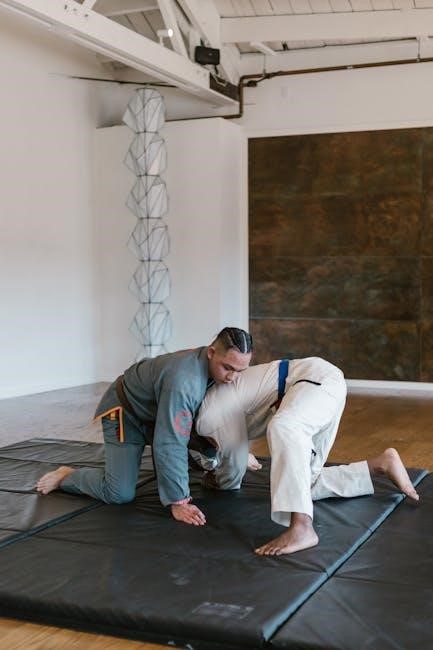
karate belt size guide
Karate belt size guide helps practitioners choose correct belts, ensuring comfort and security, with various sizes available, including adjustable and youth options, using online resources and measurement charts effectively always.
Importance of Choosing the Right Karate Belt Size
Choosing the right karate belt size is crucial for a comfortable and secure fit, allowing practitioners to focus on their technique and performance. A well-fitting belt provides confidence and motivation, while a poorly fitting one can be distracting and hinder progress. The importance of selecting the correct size cannot be overstated, as it affects not only the individual’s practice but also their overall experience and enjoyment of the martial art. By understanding the significance of proper belt size, practitioners can take the first step towards optimizing their training and achieving their goals. With the right belt size, individuals can improve their technique, increase their confidence, and enhance their overall karate experience, making it essential to prioritize proper fit and sizing. This attention to detail can have a profound impact on a practitioner’s journey, leading to greater success and fulfillment in the martial art.

Karate Belt Size Chart
Karate belt size charts provide measurements and sizes, helping practitioners determine their ideal belt length and waist size, using tables and guides effectively always online.
Understanding the Relationship Between Waist Size and Belt Length
To determine the correct karate belt size, it is essential to understand the relationship between waist size and belt length. The belt length is typically measured from the end of the belt to the knot, and it usually ranges from 2.5 to 3 times the waist size. This measurement can vary depending on the individual’s preference for a tighter or looser fit. Using a karate belt size chart, practitioners can find their corresponding belt length based on their waist size. The chart provides a guide for measuring the waist and determining the ideal belt length. By understanding this relationship, practitioners can choose the correct belt size, ensuring a comfortable and secure fit during training and competitions. This knowledge is crucial for selecting the right karate belt, and it can be applied using online resources and measurement guides effectively.

Factors to Consider When Selecting a Karate Belt
Practitioners consider age, rank, and personal preference when selecting karate belts, ensuring proper fit always with online resources.
Age Group and Recommended Belt Size
The age group of a practitioner is a crucial factor in determining the recommended karate belt size, with different sizes available for children, youth, and adults.
Online resources provide guidance on selecting the correct belt size based on age and waist measurement.
A karate belt size chart typically includes a range of sizes, from child to adult, with corresponding waist measurements and belt lengths.
The chart helps practitioners choose the right belt size, ensuring a comfortable and secure fit.
For children, the belt size is often determined by their waist measurement and age, with smaller sizes available for younger practitioners.
Youth practitioners typically require larger belt sizes, while adults require the largest sizes.
By considering the age group and recommended belt size, practitioners can ensure they have the right equipment for their martial arts training.
Using online resources and measurement charts, practitioners can easily determine their ideal belt size and purchase the correct one.
This helps to promote a safe and enjoyable training experience.

Karate Belt Size Calculator
Online calculator tools determine ideal karate belt size using waist measurement and other factors, providing accurate results quickly and easily always with simple user interface and clear instructions provided.
How to Use the Calculator to Determine Your Ideal Belt Size
To determine your ideal karate belt size, you can use an online calculator tool, which typically requires you to input your waist measurement and sometimes other factors such as age and rank.
The calculator will then provide you with a recommended belt size, taking into account the standard measurements and guidelines for karate belts.
Using a calculator can be a convenient and accurate way to determine your ideal belt size, especially if you are new to karate or unsure about what size to choose.
The calculator will also consider the type of belt you need, such as a single or double wrap belt, and provide you with the corresponding length.
Additionally, some calculators may also offer tips and recommendations for choosing the right belt size, such as considering the firmness and tolerance of the belt.
Overall, using a karate belt size calculator can help you find the perfect fit for your practice, and ensure that you are wearing a belt that is comfortable and secure.
You can find these calculators on various online platforms, including karate equipment websites and martial arts forums, and they are often free to use and easy to navigate.
By following the simple steps and inputting your measurements, you can quickly and easily determine your ideal karate belt size.
This will help you to focus on your practice and improve your skills, rather than worrying about your belt size.
The calculator is a useful tool for anyone who practices karate, regardless of their level or experience.
It provides a quick and easy way to determine the ideal belt size, and helps to ensure that you are wearing a belt that is comfortable and secure.

Tips for Ensuring a Comfortable and Secure Fit
Choose a belt with adjustable length and consider factors like firmness and tolerance for optimal comfort and security always using online resources effectively.
Adjusting for Firmness and Tolerance to Get the Perfect Fit
To get the perfect fit, it is essential to consider the firmness and tolerance of the karate belt. The firmness of the belt refers to how stiff or soft it is, and this can affect the overall fit and comfort of the belt. Some practitioners prefer a stiffer belt, while others prefer a softer one. The tolerance of the belt refers to the amount of give or stretch in the material, and this can also affect the fit. By adjusting for firmness and tolerance, practitioners can get a belt that fits comfortably and securely. This can be achieved by trying out different belts and adjusting the length and firmness to get the perfect fit. Online resources and measurement charts can also be used to help determine the ideal firmness and tolerance for a comfortable and secure fit. Effective use of these resources can ensure a perfect fit.